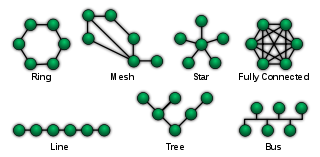Related Research Articles
An intrusion detection system is a device or software application that monitors a network or systems for malicious activity or policy violations. Any intrusion activity or violation is typically reported either to an administrator or collected centrally using a security information and event management (SIEM) system. A SIEM system combines outputs from multiple sources and uses alarm filtering techniques to distinguish malicious activity from false alarms.
Network security consists of the policies, processes and practices adopted to prevent, detect and monitor unauthorized access, misuse, modification, or denial of a computer network and network-accessible resources. Network security involves the authorization of access to data in a network, which is controlled by the network administrator. Users choose or are assigned an ID and password or other authenticating information that allows them access to information and programs within their authority. Network security covers a variety of computer networks, both public and private, that are used in everyday jobs: conducting transactions and communications among businesses, government agencies and individuals. Networks can be private, such as within a company, and others which might be open to public access. Network security is involved in organizations, enterprises, and other types of institutions. It does as its title explains: it secures the network, as well as protecting and overseeing operations being done. The most common and simple way of protecting a network resource is by assigning it a unique name and a corresponding password.
Internet traffic is the flow of data within the entire Internet, or in certain network links of its constituent networks. Common traffic measurements are total volume, in units of multiples of the byte, or as transmission rates in bytes per certain time units.
A host-based intrusion detection system (HIDS) is an intrusion detection system that is capable of monitoring and analyzing the internals of a computing system as well as the network packets on its network interfaces, similar to the way a network-based intrusion detection system (NIDS) operates. This was the first type of intrusion detection software to have been designed, with the original target system being the mainframe computer where outside interaction was infrequent.
In artificial intelligence, artificial immune systems (AIS) are a class of computationally intelligent, rule-based machine learning systems inspired by the principles and processes of the vertebrate immune system. The algorithms are typically modeled after the immune system's characteristics of learning and memory for use in problem-solving.

Dorothy Elizabeth Denning is a US-American information security researcher known for lattice-based access control (LBAC), intrusion detection systems (IDS), and other cyber security innovations. She published four books and over 200 articles. Inducted into the National Cyber Security Hall of Fame in 2012, she is now Emeritus Distinguished Professor of Defense Analysis, Naval Postgraduate School.
A protocol-based intrusion detection system (PIDS) is an intrusion detection system which is typically installed on a web server, and is used in the monitoring and analysis of the protocol in use by the computing system. A PIDS will monitor the dynamic behavior and state of the protocol and will typically consist of a system or agent that would typically sit at the front end of a server, monitoring and analyzing the communication between a connected device and the system it is protecting.
In computing, a wireless intrusion prevention system (WIPS) is a network device that monitors the radio spectrum for the presence of unauthorized access points (intrusion detection), and can automatically take countermeasures (intrusion prevention).

In data analysis, anomaly detection is generally understood to be the identification of rare items, events or observations which deviate significantly from the majority of the data and do not conform to a well defined notion of normal behaviour. Such examples may arouse suspicions of being generated by a different mechanism, or appear inconsistent with the remainder of that set of data.
Data loss prevention (DLP) software detects potential data breaches/data exfiltration transmissions and prevents them by monitoring, detecting and blocking sensitive data while in use, in motion, and at rest.
Misuse detection actively works against potential insider threats to vulnerable computer data.
Intrusion detection system evasion techniques are modifications made to attacks in order to prevent detection by an intrusion detection system (IDS). Almost all published evasion techniques modify network attacks. The 1998 paper Insertion, Evasion, and Denial of Service: Eluding Network Intrusion Detection popularized IDS evasion, and discussed both evasion techniques and areas where the correct interpretation was ambiguous depending on the targeted computer system. The 'fragroute' and 'fragrouter' programs implement evasion techniques discussed in the paper. Many web vulnerability scanners, such as 'Nikto', 'whisker' and 'Sandcat', also incorporate IDS evasion techniques.
Network behavior anomaly detection (NBAD) is a security technique that provides network security threat detection. It is a complementary technology to systems that detect security threats based on packet signatures.

Network forensics is a sub-branch of digital forensics relating to the monitoring and analysis of computer network traffic for the purposes of information gathering, legal evidence, or intrusion detection. Unlike other areas of digital forensics, network investigations deal with volatile and dynamic information. Network traffic is transmitted and then lost, so network forensics is often a pro-active investigation.

In statistics and machine learning, ensemble methods use multiple learning algorithms to obtain better predictive performance than could be obtained from any of the constituent learning algorithms alone. Unlike a statistical ensemble in statistical mechanics, which is usually infinite, a machine learning ensemble consists of only a concrete finite set of alternative models, but typically allows for much more flexible structure to exist among those alternatives.
A Hardware Trojan (HT) is a malicious modification of the circuitry of an integrated circuit. A hardware Trojan is completely characterized by its physical representation and its behavior. The payload of an HT is the entire activity that the Trojan executes when it is triggered. In general, Trojans try to bypass or disable the security fence of a system: for example, leaking confidential information by radio emission. HTs also could disable, damage or destroy the entire chip or components of it.
Fraud represents a significant problem for governments and businesses and specialized analysis techniques for discovering fraud using them are required. Some of these methods include knowledge discovery in databases (KDD), data mining, machine learning and statistics. They offer applicable and successful solutions in different areas of electronic fraud crimes.
In network security, evasion is bypassing an information security defense in order to deliver an exploit, attack, or other form of malware to a target network or system, without detection. Evasions are typically used to counter network-based intrusion detection and prevention systems but can also be used to by-pass firewalls and defeat malware analysis. A further target of evasions can be to crash a network security defense, rendering it in-effective to subsequent targeted attacks.
Deep content inspection (DCI) is a form of network filtering that examines an entire file or MIME object as it passes an inspection point, searching for viruses, spam, data loss, key words or other content level criteria. Deep Content Inspection is considered the evolution of Deep Packet Inspection with the ability to look at what the actual content contains instead of focusing on individual or multiple packets. Deep Content Inspection allows services to keep track of content across multiple packets so that the signatures they may be searching for can cross packet boundaries and yet they will still be found. An exhaustive form of network traffic inspection in which Internet traffic is examined across all the seven OSI ISO layers, and most importantly, the application layer.

Salvatore J. Stolfo is an academic and professor of computer science at Columbia University, specializing in computer security.
References
- ↑ Wang, Ke (2004). "Anomalous Payload-Based Network Intrusion Detection" (PDF). Lecture Notes in Computer Science. Vol. 3224. Springer Berlin. pp. 203–222. doi:10.1007/978-3-540-30143-1_11. ISBN 978-3-540-23123-3. Archived from the original (PDF) on 2010-06-22. Retrieved 2011-04-22.
{{cite book}}:|journal=ignored (help); Missing or empty|title=(help) - 1 2 Khalkhali, I; Azmi, R; Azimpour-Kivi, M; Khansari, M. "Host-based web anomaly intrusion detection system, an artificial immune system approach" (PDF). ProQuest.
- 1 2 A strict anomaly detection model for IDS, Phrack 56 0x11, Sasha/Beetle
- ↑ Beaver, K. "Host-based IDS vs. network-based IDS: Which is better?". Tech Target, Search Security.
{{cite web}}: Missing or empty|url=(help) - 1 2 Perdisci, Roberto; Davide Ariu; Prahlad Fogla; Giorgio Giacinto; Wenke Lee (2009). "McPAD : A Multiple Classifier System for Accurate Payload-based Anomaly Detection" (PDF). Computer Networks. 5 (6): 864–881. doi:10.1016/j.comnet.2008.11.011.
- ↑ Alonso, Samuel. "Cyber Threat hunting with Sqrrl (From Beaconing to Lateral Movement)". Archived from the original on 2021-07-31. Retrieved 2019-08-17.